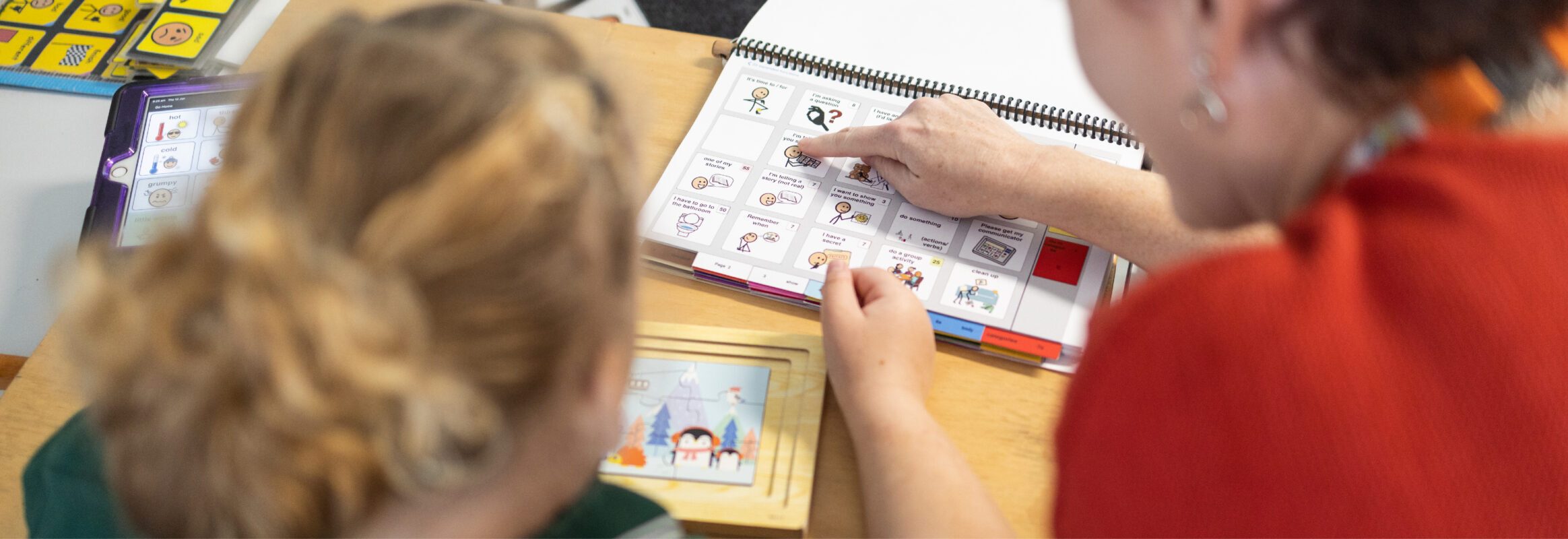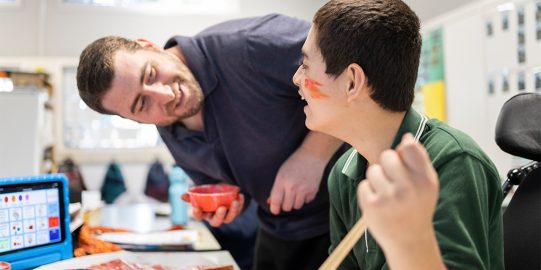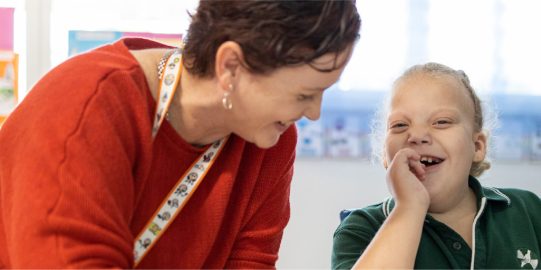A personal experience
I first heard about PODD ten years ago. It was discussed in a forum for parents of children with Angelman syndrome. This syndrome causes severe multiple disabilities. A parent complained that their child’s teacher had started using PODD for communication. The parent described a huge book of laminated pages and complex symbols. None of us could imagine how one of our children could use something like that! The parent wanted their child to just have some photos of things they could request. They were frustrated the teacher insisted that wasn’t good enough. We all agreed with the parent. We thought that surely, anyone who knows about our kids’ diagnosis should know they cannot use this.
Ten years later, I’m writing this blog while my own daughter’s PODD book is next to me on the couch. A few minutes ago, Maggie whined from her hammock and touched my leg, looking at me. I picked up her PODD and said “I hear your voice. I wonder if you have something to say.” She looked at the book and whined softly but didn’t reach for it. I said, “hmm, you might have more to say.” I turned the page to her key messages, called branch starters. I said, “it sounds like something’s wrong…” She vocalized again in the same low whine. I turned to her something’s the wrong page. I started pointing to different symbols while saying them aloud. “I wonder if you feel sick… Or if something hurts…” She whined again when I got to “uncomfortable.” I said, “I think something’s wrong and you’re uncomfortable.” I looked around and realized that the fan had been blowing directly on her. Yesterday was wicked hot and she’d been grateful for that cool blast of air. Today is cooler. I redirected the fan and Maggie settled back into her hammock with a smile of satisfaction. She’d been understood.
A powerful structure
It doesn’t take a PODD book to tell your mom to move the fan. There are other ways Maggie could have communicated this. But it’s likely I would have misunderstood. If she’d stood up and tried to move the fan herself, I would have moved it out of reach. That might have solved her problem, but her communication would have been missed. Before PODD, it’s likely that Maggie would have gotten up and moved somewhere else. She would have had to choose between hanging out with me or being comfortable. PODD has given us a structure for how we problem-solve these kinds of messages. PODD isn’t how Maggie communicates very often yet. But it’s how WE communicate, together.
Myths and reality
I know from experience that PODD is a powerful system for people who cannot speak. Despite that first complaint about PODD in our Angelman syndrome community, I now know hundreds of families who use PODD. Doctors once said that children with Angelman could not understand pretend play. They said they could not communicate beyond basic wants and needs. Now we have hundreds of examples of children with Angelman who use PODD and other AAC systems, like Proloquo2Go. They use PODD to play with Barbie, boss or insult their siblings, ask where their important people are, beg for favorite sweet treats, ask for bedtime stories, suggest somewhere to go, and more.
Notice I said, “families who use PODD.” Parents are often the primary “users.” We model it as often as we can. Our sons and daughters sometimes choose to use it themselves. Most of us have stories about how PODD helps us understand our children. Many of us have stories about how PODD helps our children understand us. Most of us have stories about when our children used PODD to say something we never knew they were thinking. These stories keep us motivated to keep making their PODD available, even when they rarely use it. Just having it there shows them that we expect they will say something if they want to. It reminds us to use it ourselves so they can learn to use it, too.
"PODD" refers to how the symbols are organized so that we can say a message. There are many levels of PODD books. Early PODD books have only 9 or 12 symbols on the display. Advanced PODD books can have as many symbols as apps like Proloquo2Go. Families move through the PODD books as our children learn to initiate messages. Our children learn they can ask questions, comment, complain, pretend, tattle, and cajole.
Who does what
Parents often learn about PODD with a big printed book with laminated pages. We wonder how a child with severe disabilities could ever learn to carry it, much less use it! What we learn over time is that the point is for US to learn to use it. We carry it. We turn the page. We watch for cues about what our kids are doing and responding to. We watch where their hands touch the page or how their faces respond to possible messages. We work together with our sons and daughters to figure out what they might have been trying to say. We use the PODD as a teaching tool as we learn to have conversations with our children.
Book and app
The PODD system can be a laminated paper book or on an electronic device, like simPODD on an iPad. Most families who use PODD have both: an app on a device that speaks words aloud as symbols are selected, and a paper book that their child can use with our support.
Modeling - How it’s done
Most parents find the paper book is an easier place to start. An electronic PODD navigates the system without the signposts that we have in the paper book. In the paper book, we can read the labels on the symbols and follow the book. If I select LET’S GO, I follow these cues to turn to PLACES. When my daughter selects SWIMMING POOL, I reply we CAN'T, but we can GO FOR A DRIVE. I select CATEGORIES to find DAYS & TIMES to tell her we can swim TOMORROW. She argues by selecting NOW and I say CAN’T/NOT TODAY, but SOON. The words that both of us need for this conversation are all there on the same page. I model how I move through the book. I speak the word CATEGORIES while I touch the symbol, then turn the page. This teaches her how she can one-day select CATEGORIES in her PODD app and get there by herself.
True power
PODD gives me a consistent structure to communicate with Maggie. This structure helps me figure out what questions Maggie is asking, what she likes and doesn’t like, where she wants to go, and what she wants to do. Before PODD, I would speak words to say that I thought she was asking. I think I often got it right, but my spoken words didn’t help HER learn how SHE could say it. Now, I use her PODD along with my spoken words. One day, when she is misunderstood, she will use her PODD independently. For now, her family, friends, and school are learning to use this PODD structure to help us communicate, together.
The other day, Maggie patted the couch next to her. I came and sat with her. Then she put her feet against my legs and shoved. My first thought was “Seriously! You ask me to sit with you and then you kick me off?!” But then I used her PODD to say “I wonder if you have something to say.” She pushed her feet more gently toward me and her PODD book. I said “I think you have more to say” and turned to the page. I said “I wonder if you are asking for an activity… Yes, I hear your voice.” I turned to her activity page and said: “I wonder if you WANT to CUDDLE.” She didn’t respond, so I looked for other options on the page. “I wonder if you want a SENSORY ACTIVITY.” She vocalized and pushed her feet at me again. I turned to her sensory page and said “I wonder if you want me to SQUEEZE your FEET.” She put her feet in my hands. I used her PODD to talk about what I was doing as I squeezed her feet and legs. I gave her JOINT compressions and MASSAGED her tight muscles. She leaned into what I was doing. She doesn’t speak, but I swear she can purr! She moved around, so I squeezed her HANDS and SHOULDERS. Finally, she moved away. I said, “I think you are ready to STOP.”
Maggie is still early in the process of learning how to use her PODD herself. The structure of PODD is teaching her how she can one day use it. Even when she doesn't touch a single symbol, it helps her communicate. That has been the power of PODD.





